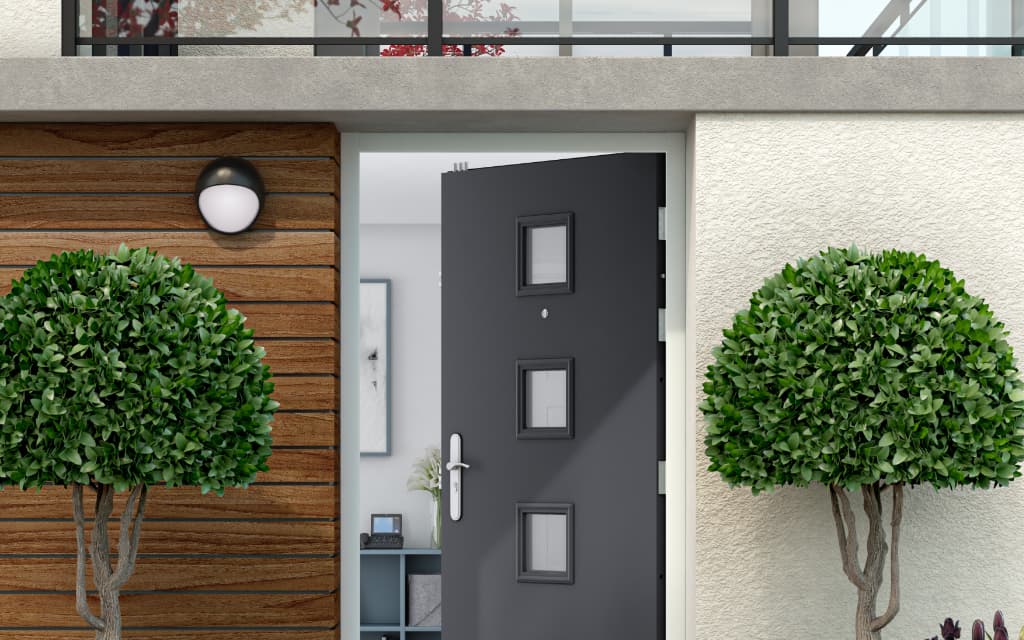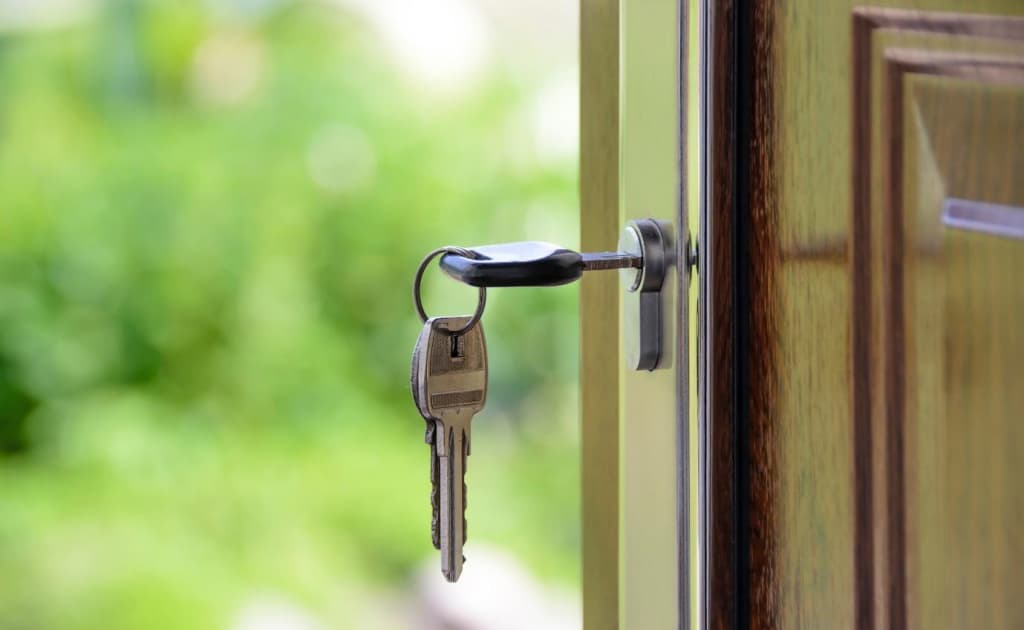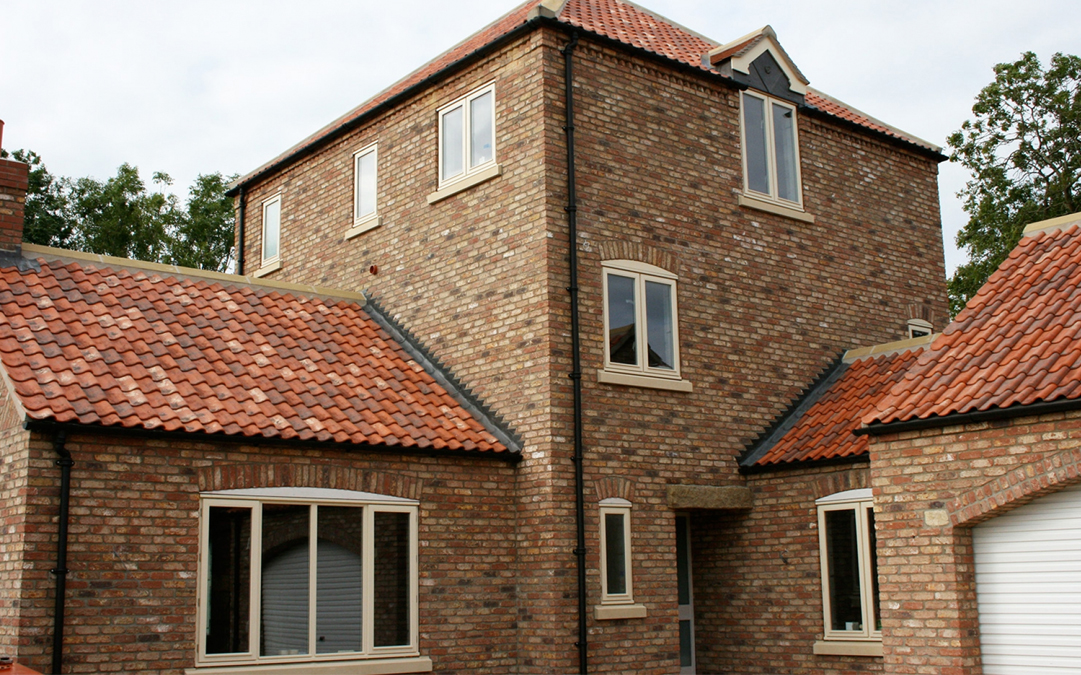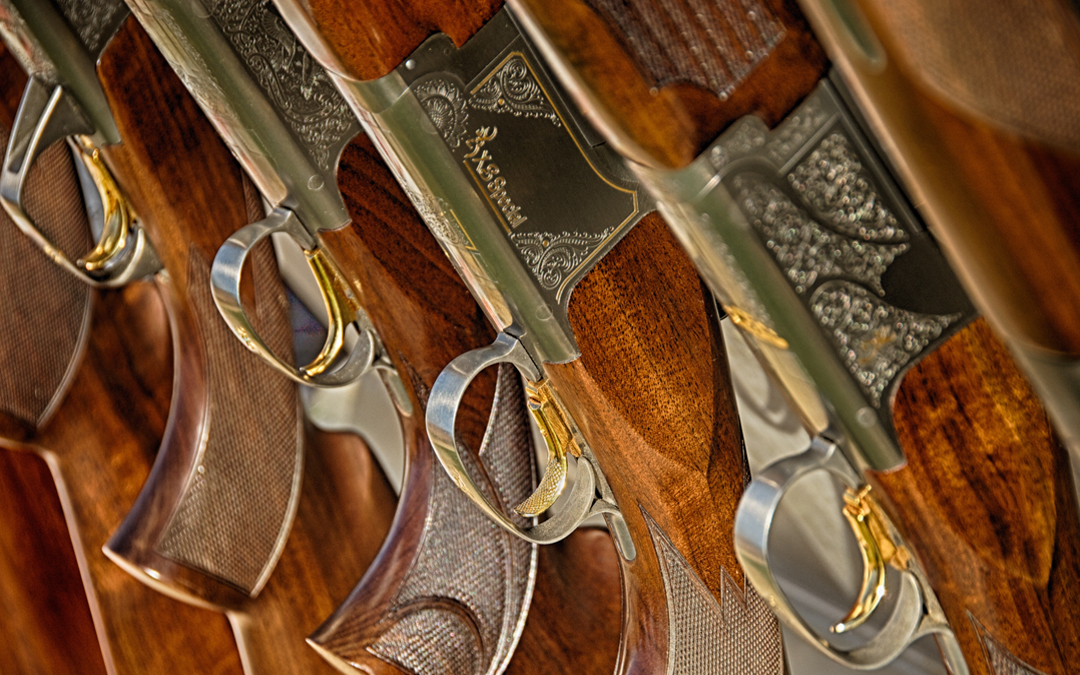A front door is an integral part of the home. It has two main purposes – providing a good first impression to visitors and protecting the home from the elements and intruders. Should you be looking to sell your home, a front door can significantly impact the curb appeal and overall value of your house. The front door of your home will also provide practical elements, including insulation, help to reduce energy costs and maintain a comfortable indoor climate.
Most importantly, a front door serves as a security barrier between your home and the outside world. With so many options and door types to choose from, it can be difficult to provide a definitive cost.
In this guide, we will try and break down the key factors to consider and provide averages for the price of front doors.

Understanding Different Types of Front Doors
It can feel overwhelming when choosing a new front door as you will be confronted with many options that come with varying price tags.
| Type of Door | Labour Cost | Supply Costs | Total Cost |
|---|---|---|---|
| Wooden | £50 – £120 | £250 – £450 | £300 – £700 |
| Fibreglass | £50 – £120 | £1000 – £2000 | £1500 – £3000 |
| Steel | £50 – £120 | £500 – £1500 | £500 – £2800 |
| Aluminum | £50 – £120 | £1,000 – £2000 | £1800 – £2500 |
| Composite | £50 – £120 | £500 – £2500 | £550 – £2620 |
| Glass | £50 – £120 | £200 – £400 | £600 – £800 |
| uPVC | £50 – £120 | £250 – £450 | £300 – £570 |
| Custom Made | £50 – £120 | £1000 – £3900 | £1050 – £4020 |
Wooden doors
Provide a classic, warm, and luxurious appeal that is hard to replicate with other materials. Robust and durable, wooden doors offer protection from intruders and the elements.
Wooden doors
Wooden front doors are fully customisable when it comes to size, shape, and design requirements. With styles ranging from country cottage panelled to Edwardian decorative glazed, wooden doors suit almost every type of property.
Maintenance Requirements
Wood is a natural material and has to be maintained and protected to help keep it in good condition. Wooden doors do require maintenance to prevent warping, rot, and insect damage. Once every six months, it is advised to brush the mechanical threshold fixed to the cill clean to remove any stones or grit. You should then wipe down the door with a damp cloth and soapy water.
Cost
When it comes to cost, wooden doors can be quite expensive due to the craftsmanship involved in the manufacturing process.
Fibreglass doors
An ideal alternative to traditional wooden doors. Less commonly known as Glass-Reinforced Polyester, the lightweight material can be designed in various styles, making it an attractive finish for front doors.
Customisation Options
These doors can mimic the look of wood with different stains and finishes, allowing you to customise the door to meet your particular design and style requirements.
Maintenance Requirements
Highly resistant to denting, warping, twisting, peeling, flaking, cracking, and fading, fibreglass doors are extremely durable and require little maintenance.
Cost
Fibreglass doors are usually moderately priced, providing a balance between cost and performance.
Steel Doors
A door made from galvanised steel will be durable, offer superior security, and because of its longevity, offer incredible value for money. Steel doors typically have an inner foam for added insulation.
Customisation Options
At Latham’s Steel Doors, our range of front steel doors is supplied with a steel frame and heavy-duty hinges, and a range of optional extras, such as upgraded cylinder locking systems, are available for extra security. They also come in a range of colours and styles.
Maintenance Requirements
A decent powder-coated finish means a steel door should not have to be repainted, compared to wooden doors which require repainting every few years. In the meantime, it’s important to clean steel doors regularly. They can also be prone to dents and scratches, which may lead to rust if not repaired.
Cost
Generally cost-effective, making them a popular choice for many homeowners. Whilst steel doors are slightly more expensive when compared with uPVC, for instance, they do not warp, are generally stronger, and therefore, more secure.
Aluminium doors
Aluminium is practical, low-maintenance, and weather-resistant. They are easy to clean, and will not rust, peel or flake. Aluminium doors offer good security and energy efficiency.
Customisation Options
These doors can be designed in a wide range of styles and finishes, including finishes that mimic wood grain.
Maintenance Requirements
Requires very little maintenance and can last a long time. Occasional cleaning with lukewarm water and pH-neutral detergent is sufficient.
Cost
Tend to be more expensive than uPVC but cheaper than high-end wood or composite doors.
Composite doors
Composite doors are an excellent choice for front doors due to their combination of strength, durability, and low maintenance requirements. Made from a blend of materials, including wood, uPVC, and glass-reinforced plastic (GRP), composite doors offer enhanced security and insulation properties. They are highly resistant to warping, fading, and cracking, making them suitable for various weather conditions. Composite doors also come in a wide range of designs, colours, and finishes, allowing homeowners to find the perfect match for their style preferences. Overall, composite doors offer a practical and visually appealing solution for front entrances.
Customisation Options
A composite door can have the same aesthetic appeal as a timber door but allows for more customisation compared to a wooden door. The glazing can be customised with styles and designs, and the doors can be produced in a variety of different colours.
Maintenance Requirements
A composite door requires virtually no maintenance, without the need to repaint or varnish it. It is advisable to keep it clean with a wet cloth to remove dirt.
Cost
The price range can vary depending on the specific mix of materials used in production.
Glass doors
Glass front doors offer a sophisticated and contemporary aesthetic, creating a visually striking entrance for your home. They have the advantage of allowing ample natural light to filter into the interior, creating a bright and inviting atmosphere. However, it’s important to consider the level of privacy they provide. Depending on the type of glass used, a glass front door may offer a clear view into your home, compromising privacy. It’s essential to choose the appropriate glass options, such as frosted or tinted glass, to strike the right balance between aesthetics and privacy.
Customisation Options
Different kinds of glass can be used to create different appearances. Frosted, opaque, and decorative glass can all be implemented to change the appearance and visibility through the glass. These doors may require reinforced frames for security.
Maintenance Requirements
Glass doors need to be maintained when they appear to get dirty. Apply special cleaning agents to the surface with a spray diffuser, and then wipe it with a dry cloth.
Cost
Can be high in price depending on the type of glass and level of craftsmanship involved.
uPVC doors
Unplasticised Polyvinyl Chloride (uPVC) doors are very popular due to their durability and low maintenance. They offer excellent insulation, helping to reduce energy costs. Some people feel uPVC doesn’t have the same aesthetic appeal as natural materials like wood.
Maintenance
These doors are popular due to their resistance to rot, rust, and corrosion, and are generally weatherproof.
Customise
uPVC doors are available in a variety of styles and colours, with the option to include glass inserts.
Cost
They typically cost less than wood, steel, and fibreglass options.

Image from pixabay.com
Price Range for Different Types of Front Doors
The cost of a new front door is dependent on many factors, including the material, style, size, and custom-made options.
Here, we look at the cost breakdown of different types of front doors.
Cost breakdown for wooden doors
The cost of a wooden front door depends on the type of wood and the craftsmanship involved.
- Basic wooden doors can start from around £157 to £240
- High-end hardwood doors, such as those made from mahogany or walnut, can cost £800 to £2400 or more
- Custom wood doors can exceed £5,000, particularly if they are large, ornate, or use premium wood
Cost breakdown for fibreglass doors
The cost of doors varies depending on style, material, colour, size of the door, and additional features.
- Basic fibreglass doors can start from around £120 – £550
- High-end fibreglass doors that mimic the look of premium wood can cost up to £1,800 or more
- Custom sizes and finishes can further increase the price
Cost breakdown for steel doors
The quality of finish, manufacturing, and materials all impact the price of a steel door.
- Standard steel doors are one of the most cost-effective options, with prices from £120 to £320
- Steel doors with high-end features, such as better insulation or premium hardware, can cost £480 to £1,000
- Custom steel doors can exceed £1,500, especially if they include features like glass inserts or intricate designs
Cost breakdown for composite doors
Composite doors range in price depending on the specific materials used in production.
- Standard composite doors typically range from £180 to £480
- Premium composite doors can cost anywhere from £800 to £3,000, particularly if they use high-end materials or custom designs
Cost breakdown for glass doors
The cost is dependent on the type of glass used in production and whether it is reinforced with security measures.
- Basic glass doors can start around £300 to £700
- High-end or custom glass doors can easily exceed £1,000 to £4,000 depending on the type of glass, the degree of customisation, and the complexity of the design
- Added security features or speciality glass types can increase the price further
Cost breakdown for uPVC doors
Are known for their affordability and value for money, making them a popular option for homeowners on a budget.
- Basic uPVC doors can start from around £200 to £400
- uPVC doors with glass inserts or detailed designs can range from £500 to £1,000
- Custom uPVC doors with high-end features can cost £1,500 or more
Cost breakdown for aluminium doors
Generally sit in the mid-range for door pricing, as the cost of materials is higher compared to uPVC and wooden.
- Basic aluminium doors can start around £400 to £700
- Higher-end aluminium doors with features such as double glazing or special finishes can range from £1,000 to £2,000
- Custom aluminium doors can exceed £3,000, particularly if they include large glass panels or bespoke designs

Image from pixabay.com
Key Factors That Affect the Cost of a New Front Door
The cost of a new front door can be significantly impacted by several factors, including its size, delivery, and material used.
Material
Wood, fibreglass, steel, composite, glass, and uPVC all come at different price points. It’s important to consider that the more durable materials often cost more upfront. However, in the long run, doors made from stronger materials, such as steel, will require less maintenance, be more durable, and will save you money on energy bills as they provide better insulation.
Size
Standard-sized doors are typically less expensive. Larger or custom-sized doors often cost more due to increased material usage and the complexity of installation.
Style
Basic styles are typically more affordable. More elaborate or customised styles, such as doors with intricate carvings or unique shapes, will increase the cost.
Custom features
Additional elements, such as transom windows, sidelights, or speciality hardware can significantly add to the cost of a front door. Custom paint jobs or finishes can also increase the overall price.
Energy efficiency
Doors with superior insulating properties or Energy Star ratings often cost more upfront but can lead to energy savings over time. Additional elements like thermal breaks, weatherstripping, and low-E coatings can improve energy efficiency but may add to the cost.
Security features
Basic doors might have a standard lock set, while higher-end models might include deadbolts, smart locks, or biometric systems, adding to the cost. Reinforced frames, peepholes, security glass, and other security elements also increase the price.
Additional Costs to Consider
There are several additional costs to factor in when budgeting for a new front door.
Delivery and Installation
Delivery costs can range anywhere from £50 to £200 depending on the distance and the size/weight of the door. Professional installation costs are dependent on labour rates in your area but typically range from £100 to £500.
Door Hardware
Basic hardware sets can start around £40, but high-end or smart lock systems can cost several hundreds of pounds. Additional hardware, such as a peephole, door knocker, or mail slot can also add to the total cost.
Potential need for a new doorframe
If your existing frame is damaged or you’re changing door sizes, you may need a new frame. The cost of a new door frame typically ranges from £150 to £300, not including labour costs. All of Latham’s steel front doors come with a steel frame.
Cost of disposing of the old door
Some companies include disposal in their installation fee, but others may charge extra. If you are disposing of it yourself, check local regulations for potential fees.
Paint or finish costs
If your door does not come pre-finished, you will need to account for painting or staining costs. If you employ a professional to paint your front door, it will cost between £150 and £300, depending on the type of front door.
Paint or finish costs
In conclusion, the cost of a new front door is entirely dependent on many factors, which include the materials used, its size, customisation, and additional costs, such as additional hardware, delivery fees, and paintwork.
With the variety of front doors available on the market, it means there is a front door to suit all budgets. It may feel sensible to choose a front door from a lower price range, however, it’s important to remember that a door that costs more upfront, due to superior insulating property and less maintenance, will save you money in the long run.



